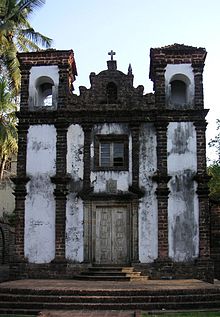The indigenous population of the erstwhile Portuguese colony of Goa, Daman and Diu was christianised following the Portuguese conquest of Goa in 1510 and the subsequent establishment of the Inquisition of Goa. The converts in the Velhas Conquistas (Old Conquests) to Roman Catholicism were then granted full Portuguese citizenship.[1] Almost all present-day Goan Catholics are descendants of these native converts; they constitute the largest Indian Christian community of Goa state and account for 25 percent of the population.[2]

Many Kudali, Mangalorean and Karwari Catholics in present-day Karnataka and Maharashtra share common origins with Goans, due to migration in the 16th and 17th centuries.[3] Korlai and Bombay East Indian Catholics of the Konkan division, and the Damanese of Daman, Diu and Silvassa have had Goan admixture and interactions in the Portuguese Bombay territory, which was ruled from the capital in Old Goa. Bombay East Indians were formerly Portuguese citizens until the seven islands of Bombay were taken over by the British East India Company, via the dowry of Catherine de Braganza in marriage to Charles II of England. Salsette islanders and Basseinites of the Bombay East Indian community were also Portuguese citizens, till the Mahratta Invasion of Bassein in 1739.[4]
- ^ Holm 1989, p. 286
- ^ de Mendonça 2002, p. 55
- ^ Prabhu 1999, p. 154
- ^ Machado, Dolcy M (29 April 2011). History and military importance of medieval Bassein and its surroundings. University of Pune.